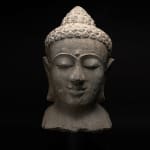Monumental Javanese Head of the Buddha, Ninth Century AD
Stone
68.6 x 38.1 x 45 cm
27 x 15 x 17 3/4 in
27 x 15 x 17 3/4 in
CB.2928
Further images
-
(View a larger image of thumbnail 1
)

-
(View a larger image of thumbnail 2
)

-
(View a larger image of thumbnail 3
)

-
(View a larger image of thumbnail 4
)

-
(View a larger image of thumbnail 5
)

-
(View a larger image of thumbnail 6
)

-
(View a larger image of thumbnail 7
)

-
(View a larger image of thumbnail 8
)

-
(View a larger image of thumbnail 9
)

-
(View a larger image of thumbnail 10
)

-
(View a larger image of thumbnail 11
)

This is a stone sculpture of a Buddha from Borobudur. It has a large forehead, an oval shaped face, and a pointed chin. Eyebrows curved and conjoined, his eyes are...
This is a stone sculpture of a Buddha from Borobudur. It has a large forehead, an oval shaped face, and a pointed chin. Eyebrows curved and conjoined, his eyes are gazing downwards with compassion and mercy. The bridge of this nose was straight and low, lip small and pointed forward with a clear cleft above the upper lip. Although only the head remains, from its size we can deduce how impressive would it originally be together with the torso. Its natural and serene outlook reflects the exceptional quality of this piece.
The Indonesian Buddhist monument famous throughout the world, Candi Borobudur, is situated in the plain of Kedu to the North of Yogyakarta. The architectural design of Borobudur symbolizes Buddhist doctrines and cosmology. It provides visitors and devotees with a processional path towards the Highest Truth. The lower levels represents Kamadhatu, the world of desires. Murals and lintels demonstrate the fundamental law of cause and effect (Mahakarma-vibhanga, or simply karma), and how desires leads to samsara, the cycle of rebirth, the ultimate form of suffering since these desires are never fully satisfied. Ascending to the middle levels, they enter Rupadhatu, the world of form and appearances. The galleries depict the stories of the Buddha, both previous lives (jatakas) and his last life as buddha Shakyamuni. There are also stories of other Buddhist saints. They provide a practical answer to how one should live according to Buddhist doctrines. The upper levels represent Arupadhatu, the World without form and appearances. These levels, facing the directions, are populated with corresponding cosmic Buddhas, with Vaircocana, the dharmakaya of Buddha Shakyamuni, presiding on the top of the building. It is highly probable for this Buddha head to have come from the upper levels. It might very well have been a part of a cosmic Buddha. This is an extremely rare piece since the arrival of Islam around the 16th century has brought about the imminent collapse and wipe-out of Buddhist culture in Java. Had it not been concealed in the forests and not unveiled again until 1885, the grand architecture of Borobudur would not have survived the iconoclast.
Danny Ching
The Indonesian Buddhist monument famous throughout the world, Candi Borobudur, is situated in the plain of Kedu to the North of Yogyakarta. The architectural design of Borobudur symbolizes Buddhist doctrines and cosmology. It provides visitors and devotees with a processional path towards the Highest Truth. The lower levels represents Kamadhatu, the world of desires. Murals and lintels demonstrate the fundamental law of cause and effect (Mahakarma-vibhanga, or simply karma), and how desires leads to samsara, the cycle of rebirth, the ultimate form of suffering since these desires are never fully satisfied. Ascending to the middle levels, they enter Rupadhatu, the world of form and appearances. The galleries depict the stories of the Buddha, both previous lives (jatakas) and his last life as buddha Shakyamuni. There are also stories of other Buddhist saints. They provide a practical answer to how one should live according to Buddhist doctrines. The upper levels represent Arupadhatu, the World without form and appearances. These levels, facing the directions, are populated with corresponding cosmic Buddhas, with Vaircocana, the dharmakaya of Buddha Shakyamuni, presiding on the top of the building. It is highly probable for this Buddha head to have come from the upper levels. It might very well have been a part of a cosmic Buddha. This is an extremely rare piece since the arrival of Islam around the 16th century has brought about the imminent collapse and wipe-out of Buddhist culture in Java. Had it not been concealed in the forests and not unveiled again until 1885, the grand architecture of Borobudur would not have survived the iconoclast.
Danny Ching










